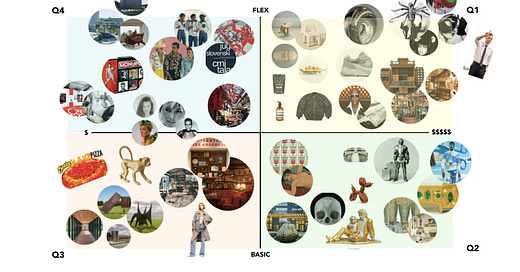Welcome to Just Two Things, which I try to write daily, five days a week. Some links may also appear on my blog from time to time. At my son’s suggestion I have linked the main articles in the heading as well as the text, to make them easier to find.
To be honest, I’m not completely sure about these quadrants, but they raise enough questions to be worth sharing. Ana Andjelic writes a weekly newsletter about brands and branding, and last week she offered us a new map of “taste”. (We’re talking “taste” as in Baudrillard, not as in cuisine.)
(Source: Ana Andjelic)
The top half is taste as irony, etc, and the bottom as straightforward expression—which for me might also map onto Richard Inglehart’s post-materialist values at the top (about autonomy and self-expression) and modern/materialist values (about status and conformity) at the bottom.
The left/right split is about money: lots at the right, nots at the left. There’s lots more detail in her piece, but this is her summary:
The top two quadrants (Q1 and Q4) are about status signaling through showing off one’s cultural savvy and plugged in-ness. This is the territory of the modern aspirational economy, and has less to do with money and more with having knowledge, aesthetic sensibility and the right creative network. Examples are: Telfar, downtown art galleries, food and drink connoisseurship, road trips, small wooden stools.
The bottom two quadrants are the domain of traditional economy, where price is the key determinant of access and signal of status. This territory spans from Zara to Prada, and is often directed by the same aesthetic. Dynamics in this taste market is a cycle of imitation and distinction. Trends are created in Q2, then imitated and scaled in Q3. This imitation of products, people, places and ideas that diminishes their exclusivity and value. Examples are accessibility of once unique places like art institutions in rural areas (Storm King, Louisiana Museum), speakeasy and coffee shop aesthetics, luxury fashion trends.
Q1 and Q4 create social distinction. Q3 creates economic distinction.
And Q2? It’s about kitsch. Expensive kitsch. It gives those of us who think we’re in the top half something to look down on. That’s what ‘taste’ does.
#2: Sustainability books of 2020
Jeremy Williams’ Earthbound blog is one of my regular stops for tracking sustainability issues, and he’s also a keen reader and reviewer. I’m hoping that it’s not too far into 2021 to mention his ‘top five’ books for 2020.
James Suzman, Affluence Without Abundance
Merlin Sheldrake, Entangled Life (about the mysteries of fungi)
Ibram X Kendi, How to be an Anti-Racist
Ayana Elizabeth Johnson and Katherine Wilkinson (eds), All We Can Save
Jason Hickel, Less is More
You can by them via Earthbound Books and the non-Amazon online site Bookshop here (UK), or here (USA).
Feedback
In a response to the Fintan O’Toole article on Trumpism and misgovernment that I shared on Friday, Daniel Hobbs mentioned to me Michael Lewis’ book The Fifth Risk. There’s a pocket review here in Kirkus, Michael Lewis is interviewed here about the book.
j2t#006



